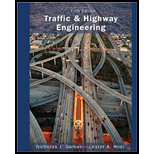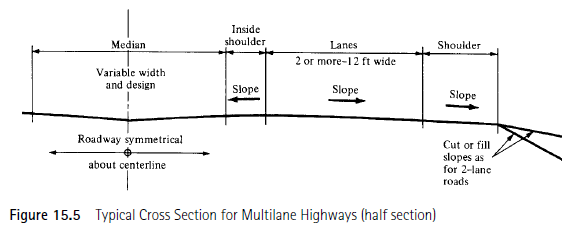
(a)
Suitable design speed for the rural collector highway.
Answer to Problem 1P
Explanation of Solution
Given information:
In mountains terrain is designed to carry volume of

For a rural collector highway located in mountains terrain is designed to carry a design volume
From the table the design speed for
(b)
Lane and usable shoulder lengths for the rural collector highway.
Answer to Problem 1P
Lane=
Shoulder =
Explanation of Solution
Given information:
In mountains terrain is designed to carry volume of
For a rural collector highway located in mountains terrain is designed to carry a design volume

From the figure
Width of shoulder is total
(c)
Maximum desirable grade for the rural collector highway.
Answer to Problem 1P
Maximum desirable grade=
Explanation of Solution
Given information:
In mountains terrain is designed to carry volume of

From the Table
Want to see more full solutions like this?
Chapter 15 Solutions
Traffic and Highway Engineering - With Mindtap
- A six-lane freeway (three lanes in each direction) has regular weekday users and currently operates at maximum LOS C conditions. The lanes are 11 ft wide, the right-side shoulder is 4 ft wide, and there are two ramps within three miles upstream of the segment midpoint and one ramp within three miles downstream of the segment midpoint. The highway is on rolling terrain with 10% large trucks and buses (no recreational vehicles), and the peak-hour factor is 0.90. a.) Determine the Free Flow Speedarrow_forwardA six-lane freeway (three lanes in each direction) has regular weekday users and currently operates at maximum LOS C conditions. The lanes are 11 ft wide, the right-side shoulder is 4 ft wide, and there are two ramps within three miles upstream of the segment midpoint and one ramp within three miles downstream of the segment midpoint. The highway is on rolling terrain with 10% large trucks and buses (no recreational vehicles), and the peak-hour factor is 0.90. b.) Determine the adjustment factor (f). (Express in three decimals)arrow_forwardA six-lane freeway (three lanes in each direction) has regular weekday users and currently operates at maximum LOS C conditions. The lanes are 11 ft wide, the right-side shoulder is 4 ft wide, and there are two ramps within three miles upstream of the segment midpoint and one ramp within three miles downstream of the segment midpoint. The highway is on rolling terrain with 10% large trucks and buses (no recreational vehicles), and the peak-hour factor is 0.90. Determine the hourly volume for these conditions.arrow_forward
- A four-lane basic freeway segment on level terrain is being redesigned. The current roadway has 12 ft lanes with 4 ft shoulders. The proposed alignment would expand to six 11-ft lanes with 2 ft shoulders. The road carries 3000 vehicles in the peak hour in one direction, with 925 coming in the peak 15 minutes. The truck mix is 70/30 and makes up 10% of traffic. What is the density and LOS (level of service) before and after the proposed change?arrow_forwardAn urban freeway is to be designed using the following information. AADT = 52,500 veh/day K (proportion of AADT occurring during the peak hour): D (proportion of peak hour traffic traveling in the peak direction): Trucks: PHF = 0.94 Lane width: Shoulder width: Total ramp density: Terrain: 3 Determine the number of lanes in the peak direction required to provide LOS C. (Assume commuter traffic and assume no RVs.) lanes. 0.12 0.65 8% of peak hour volume demand flow rate 12 ft 10 ft 0.5 interchange/mile; all interchanges are to be cloverleaf interchanges rolling HV' Show all calculations required. (Calculate your answers for the peak direction only. Enter fy, the peak hour volume in veh/h, the free flow speed in mi/h, the demand flow rate in pc/h/In, the mean speed in mi/h, and the density in pc/mi/ln.) fHV peak hour volume 0.893 free flow speed mean speed density 6300 X Your response differs from the correct answer by more than 10%. Double check your calculations. veh/h 1500 X Your…arrow_forwardA six-lane freeway (three lanes in each direction) in mountainous terrain has 10-ft lanes and obstructions 1 ft from the right edge. There are five ramps within three miles upstream of the segment midpoint and four ramps within three miles downstream of the segment midpoint. The traffic stream consists of mostly commuters with a peak hour factor of 0.84, peak-hour volume of 2500 vehicles, and 4% recreational vehicles. What is the level of service? (Write the letter only)arrow_forward
- A six-lane freeway (three lanes in each direction) in mountainous terrain has 10-ft lanes and obstructions 5 ft from the right edge. There are zero ramps within three miles upstream of the segment midpoint and one ramp within three miles downstream of the segment midpoint. The traffic stream consists of mostly commuters with a peak hour factor of 0.84, peak-hour volume of 2500 vehicles, and 4% recreational vehicles. What is the level of service?arrow_forwardA six-lane freeway (three lanes in each direction in mountainous terrain has 10-ft lanes and obstructions 1ft from the right edge. There are five ramps within three miles upstream of the segment midpoint and four ramps within three miles downstream of the segment midpoint. The traffic stream consists of mostly commuter with a peak hour factor of 0.84, peak-hour volume of 2500 vehicles, and 4% recreational vehicles. What is the level of service?arrow_forwardA four-lane freeway (two lanes on each direction) is located on mountainous terrain with 11-ft lanes, a 5-ft right-side shoulder, and a 3-ft left-side shoulder, and a 60- mph design speed. The freeway currently operates at capacity during the peak hour. If an additional 11-ft lane is added, and all other factors stay the same, what will the new level of service be?arrow_forward
- A four-lane freeway with the following characteristics: ten foot travel lanes lateral obstructions at 0 feet at the roadside total ramp density is 4.5 ramps/mile rolling terrain The roadway has a current peak demand volume of 3500 veh/h. The peak hour factor is 0.95 and there are no trucks, buses, or RVs in the traffic stream because the roadway is classified as a parkway and such vehicles are prohibited. At what level of service will the freeway operate during its peak period of demand?arrow_forwardA basic segment of a rural freeway has the following characteristics: • Four-lanes (two lanes in each direction)%3B There is one ramp within 3 miles upstream, and 2 ramps within 3 miles downstream; 10-ft lanes; Right shoulder width of 4 ft; • Level terrain;. 10% trucks and 5% buses in the vehicle stream. Calculate the FFS at this freeway section and then determine the level of service (LOS) when the flow rate is 1740 pc/h/In. (Write the answer for the LOS in the box below).arrow_forwardASAP PLSarrow_forward
 Traffic and Highway EngineeringCivil EngineeringISBN:9781305156241Author:Garber, Nicholas J.Publisher:Cengage Learning
Traffic and Highway EngineeringCivil EngineeringISBN:9781305156241Author:Garber, Nicholas J.Publisher:Cengage Learning
